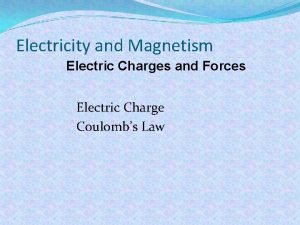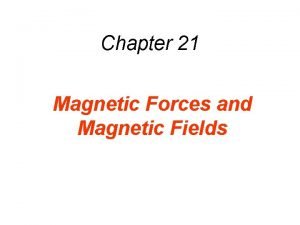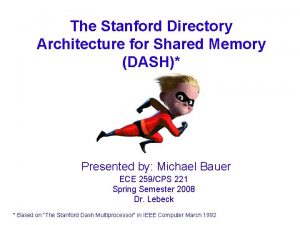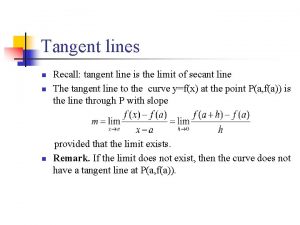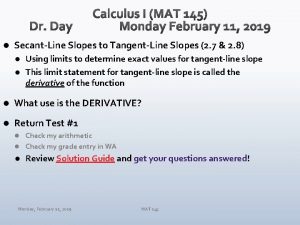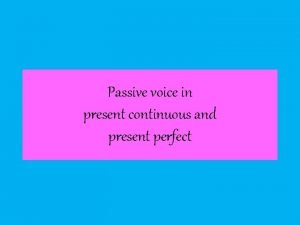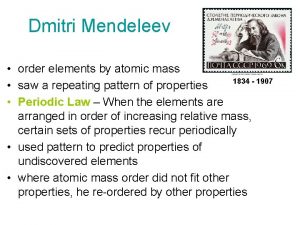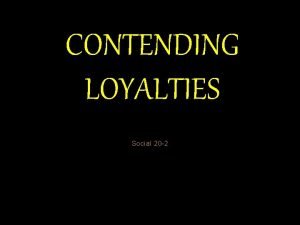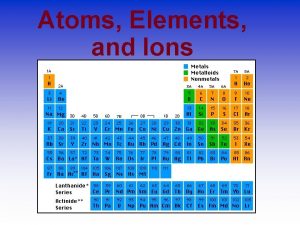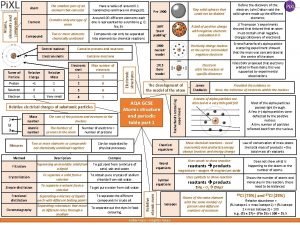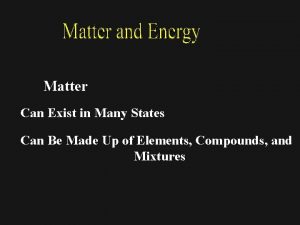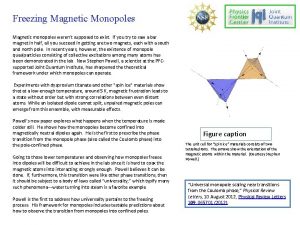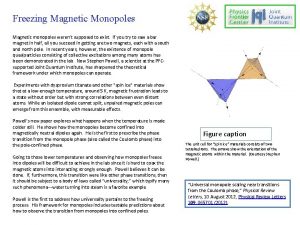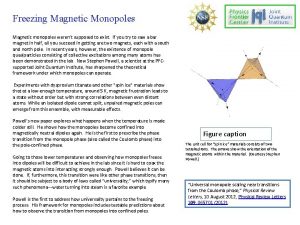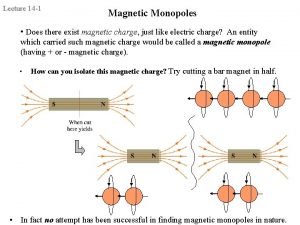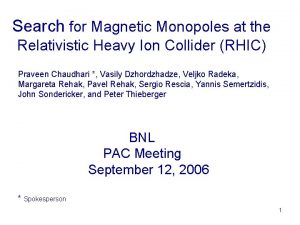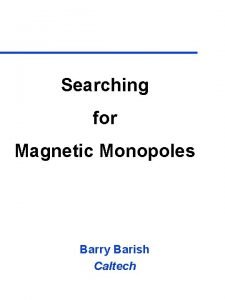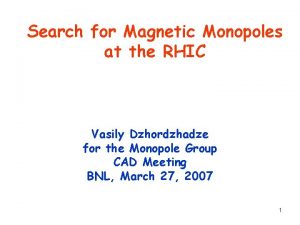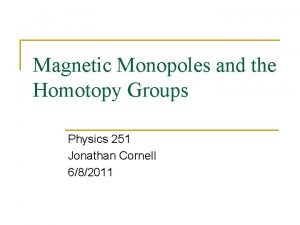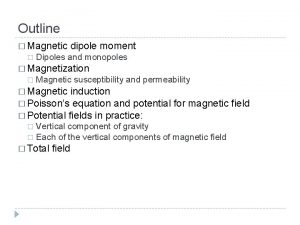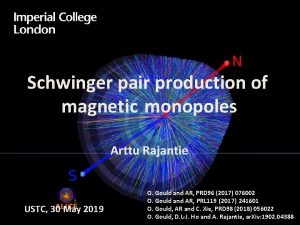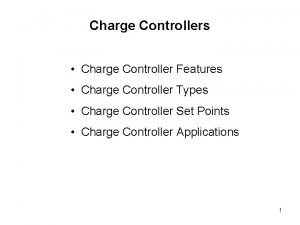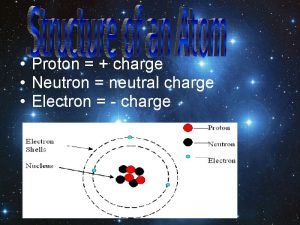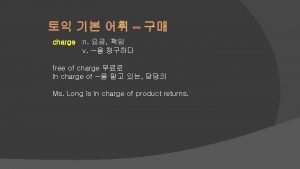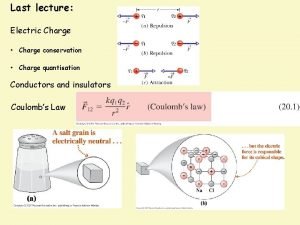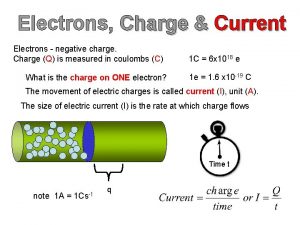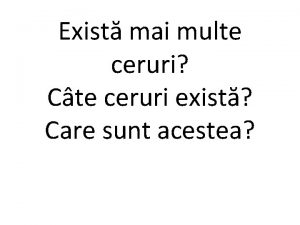Magnetic Monopoles Does there exist magnetic charge just






























- Slides: 30

Magnetic Monopoles • Does there exist magnetic charge, just like electric charge? An entity which carried such magnetic charge would be called a magnetic monopole (having + or - magnetic charge). v How can you isolate this magnetic charge? half. Try cutting a bar magnet in • In fact no attempt has been successful in finding magnetic monopoles in nature.

v The magnetic field produced by the current is perpendicular to the direction of the current. v The magnetic field lines produced by a straight, current-carrying wire form circles centered on the wire. l l The right-hand rule gives the direction of the field lines: with the thumb in the direction of the current, the fingers curl in the direction of the field lines produced by that current. The effect gets weaker as the compass is moved away from the wire. http: //www. falstad. com/vector 3 dm/

v Two parallel current-carrying wires exert an attractive force on each other when the two currents are in the same direction, otherwise they repel. 3

v Two parallel current-carrying wires exert an attractive force on each other when the two currents are in the same direction, otherwise they repel. l The force is proportional to the two currents (I 1 and I 2) and inversely proportional to the distance r between the two wires: l One ampere (A) is the amount of current flowing in each of two parallel wires separated by a distance of 1 meter that produces a force per unit length on each wire of 2 x 10 -7 N/m. 4

Two long parallel wires carry currents of 5 A and 10 A in opposite directions as shown. What is the magnitude of the force per unit length exerted by one wire on the other? a) b) c) d) e) 2. 0 x 10 -6 N/m 5. 0 x 10 -6 N/m 2. 0 x 10 -4 N/m 50 N/m 1000 N/m 5

Two long parallel wires carry currents of 5 A and 10 A in opposite directions as shown. What is the total force exerted on a 30 -cm length of the 10 -A wire? a) b) c) d) e) 2. 0 x 10 -6 N 3. 0 x 10 -6 N 2. 0 x 10 -5 N 6. 0 x 10 -5 N 2. 0 x 10 -4 N 6

Quiz: Two long parallel wires carry currents of 5 A and 10 A in opposite directions as shown. What are the directions of the forces on each wire? a) b) c) d) e) The wires exert an attractive force on each other. The wires exert a force repelling each other. Each wire exerts a force on the other in the direction of the other wire’s current (the red arrows shown). Each wire exerts a force on the other in the direction opposite to the other one’s current. The wires exert no force on each other. 7

v Magnetic forces are exerted by magnets on other magnets, by magnets on current-carrying wires, and by current-carrying wires on each other. l l l The force exerted by one wire on the other is attractive when the currents are flowing in the same direction and repulsive when the currents are flowing in opposite directions. The magnetic force exerted on a moving charge of an electric current is perpendicular to both the velocity of the charges and to the magnetic field. This force is proportional to the quantity of the charge and the velocity of the moving charge and to the strength of the magnetic field:

v For this relationship to be valid, the velocity must be perpendicular to the field. v This actually defines the magnetic field as the force per unit charge and unit of velocity: units: 1 tesla (T) = 1 N/A m §If the index finger of the right hand points in the direction of the velocity of the charge, and the middle finger in the direction of the magnetic field, then the thumb indicates the direction of the magnetic force acting on a positive charge.

An Electron moves to the left in a space filled with magnetic field pointing into the page, what’s the direction of the force? v A). Up v B). Right v C). Left v D). down v E) out of the page

An Electron moves to the same direction as the magnetic field points to, i. e. into the page, what’s the direction of the force? v A). Up v B). Right v C). Left v D). down v E). No force on the electron

6 B-02 Force on a Moving Charge Investigating the behavior of moving charge in magnetic field Forc e Which orientation of the magnet causes the beam to move upward ? Downward ? V┴ ld ie F B- F = q (v┴ B) MAGNETIC FIELD CAUSES THE CHARGED PARTICLES TO DEFLECT. WE FIND THE DIRECTION OF FORCE WITH THE RIGHT-HAND RULE. THIS IS THE FORCE ON POSITIVE CHARGE! Physics 214 Fall 2010 10/17/2021 12

6 B-06 Magnetic Force on a Current-Carrying Conductor Finding the direction of Force on Current due to B-field Based on the direction of the Magnetic Field and the direction that current flows, can you predict in which direction the Force points ? B F I┴ F/L = I┴ B Use right-hand rule to find direction of F CURRENT FLOWING ALONG THE AXLE IS PERPENDICULAR TO THE MAGNETIC FIELD. THERE IS A FORCE ON THE AXLE, CAUSING IT TO ROLL. IF THE CURRENT IS REVERSED, THE AXLE ROLLS IN THE OPPOSITE DIRECTION. Physics 214 Fall 2010 10/17/2021 13

Two long parallel wires carry currents of 5 A and 10 A in opposite directions as shown. What is the direction of the magnetic field produced by the 5 -A wire at the position of the 10 -A wire? a) b) c) d) e) f) Perpendicular to the plane of the page and into the page Perpendicular to the plane of the page and out of the page Upward Downward Inward toward the other wire Outward away from the other wire Perpendicular to plane of page and into page

Two long parallel wires carry currents of 5 A and 10 A in opposite directions as shown. What is the direction of the magnetic force acting on the 10 -A wire? a) b) c) d) e) f) Perpendicular to the plane of the page and into the page Perpendicular to the plane of the page and out of the page Upward Downward Inward toward the other wire Outward away from the other wire

v Because the force is perpendicular to the velocity of the particle, the force does no work on the particle. l It cannot increase the particle’s kinetic energy; it only serves to change the direction of the particle’s motion. l It provides a centripetal acceleration. l If the charge is moving perpendicular to a uniform magnetic field, the particle will follow a circular path. http: //www. surendranath. org/Apple ts/Electricity/Mov. Chg. Mag/MCM. h tml

Ch 14 CP 2 Small metal ball has charge q = +0. 05 C and mass, m = 0. 025 kg. Ball enters a region of magnetic field B = 0. 5 T that is perpendicular to its velocity v = 200 m/s. Centripetal acceleration = v 2/r. What is radius of the curve ball will move thru in magnetic field? A. B. C. D. E. 200 m 100 m 250 m 120 m 50 m . . . . Physics 214 Fall 2010 10/17/2021 17

. . . . Ch 14 CP 2 (cont) a) F = qv 1 B = (0. 05)(200)(0. 5) = 5 N b) (see diagram) Force in –z direction c) F = ma = qv 1 B = 5 N a = 5 N/0. 025 kg = 200 m/s 2 d) v 2/r = 200 m/s 2 , r = v 2/(200 m/s 2) = (200 m/s)2/200 m/s 2 = 200 m Physics 214 Fall 2010 10/17/2021 18

More complicated situations? Also non-uniform B v is not perpendicular to B magnetic bottle helical motion (spiral) http: //glencoe. mcgrawhill. com/sites/0098458137/student_vie w 0/chapter 24/magnetic_field_applet. h tml Van Allen belts

Quiz: A proton moves to the left in a space filled with magnetic field pointing into the page, what’s the direction of the force? v A). Up v B). Right v C). Left v D). down v E) out of the page

Back Up Slides

Alternating Current and Household Circuits v The current we draw from a wall outlet is alternating current (ac) rather than direct current (dc). l l l Direct current implies that the current flows in a single direction from the positive terminal of a battery or power supply to the negative terminal Alternating current continually reverses its direction -- it flows first in one direction, then in the other, then back again. In North America the ac goes through 60 cycles each second (60 Hz).

v The plot of electric current as a function of time for an alternating current is a sinusoidal curve. l The effective current or rms current is obtained by squaring the current, averaging this value over time, and taking the square root of the result. l The effective current Ieff is 0. 707 times the peak current Ipeak.

v If we plot the voltage across an electrical outlet as a function of time, we get another sinusoidal curve. l The effective value of this voltage is typically between 110 and 120 volts in North America. l The standard household power supplied in this country is 115 volts, 60 hertz ac.

A 60 -W light bulb is designed to operate on 120 V ac. What is the effective current drawn by the bulb? a) b) c) d) e) 0. 2 A 0. 5 A 2. 0 A 7200 A

v Household circuits are wired in parallel so that different appliances can be added to or removed from the circuit without affecting the voltage available. l l l As you add more appliances, the total current drawn increases, because the total effective resistance of the circuit decreases when resistances are added in parallel. Since too large a current could cause the wires to overheat, a fuse or circuit breaker in series with one leg of the circuit will disrupt the circuit if the current gets too large. Appliances with larger power requirements (stoves, clothes dryers, etc) are usually connected to a separate 220 -V line.

v A voltmeter measures the voltage difference between two points in a circuit, or across an element in a circuit l l It is inserted in parallel with the element whose voltage difference is being measured. A voltmeter should have a large resistance, so that it does not divert much current from the component whose voltage is being measured.

In the circuit shown, the circle with a V in it represents a voltmeter. Which of the following statements is correct? a) b) c) The voltmeter is in the correct position for measuring the voltage difference across R. No current will flow through the meter, so it will have no effect. The meter will draw a large current. The correct statement is (a). A voltmeter is a highresistance device connected in parallel with whatever circuit element it is desired to measure the voltage across.

v An ammeter measures the electric current flowing through a point in a circuit. l l l It is inserted in series into the circuit whose current is being measured, so that all the current flows through it. An ammeter should have a small resistance, so that its effect on the current is small. If you place an ammeter directly across the terminals of a battery, you could damage the meter and the battery.

In the circuit shown, the circle with an A in it represents an ammeter. Which of the following statements is correct? a) b) c) The meter is in the correct position for measuring the current through R. No current will flow through the meter, so it will have no effect. The meter will draw a significant current from the battery. The answer is (c). An ammeter is a low-resistance device and is to be placed in series in the circuit, just as a flowmeter is placed in a fluid circuit.
 Maxwell's equations magnetic monopoles
Maxwell's equations magnetic monopoles Did paris love juliet?
Did paris love juliet? Static electricity
Static electricity Electric force equation
Electric force equation Does magnetic field exerts force on a static charge
Does magnetic field exerts force on a static charge Does dash still exist
Does dash still exist Equation of a tangent line
Equation of a tangent line Does magenta exist
Does magenta exist Where does derivative not exist
Where does derivative not exist When does limit exist
When does limit exist Why do businesses exist
Why do businesses exist What is development gap
What is development gap If you can't measure it, you can't manage it
If you can't measure it, you can't manage it Present perfect continuos passive
Present perfect continuos passive Difference between charge and electric charge
Difference between charge and electric charge Difference between charge and electric charge
Difference between charge and electric charge Force of magnetic field
Force of magnetic field Distinguish between soft and hard magnetic materials
Distinguish between soft and hard magnetic materials Units of magnetic flux density
Units of magnetic flux density Magnetic moment and magnetic field relation
Magnetic moment and magnetic field relation Magnetic field and magnetic force
Magnetic field and magnetic force What is diction in poetry
What is diction in poetry Why do cities exist
Why do cities exist How far did vikings travel
How far did vikings travel Why do markets exist?
Why do markets exist? Which elements exist as diatomic molecules
Which elements exist as diatomic molecules Contending loyalties in canada
Contending loyalties in canada Diatomic elements
Diatomic elements Smallest non metal
Smallest non metal Do pirates still exist
Do pirates still exist Matter can exist as
Matter can exist as



